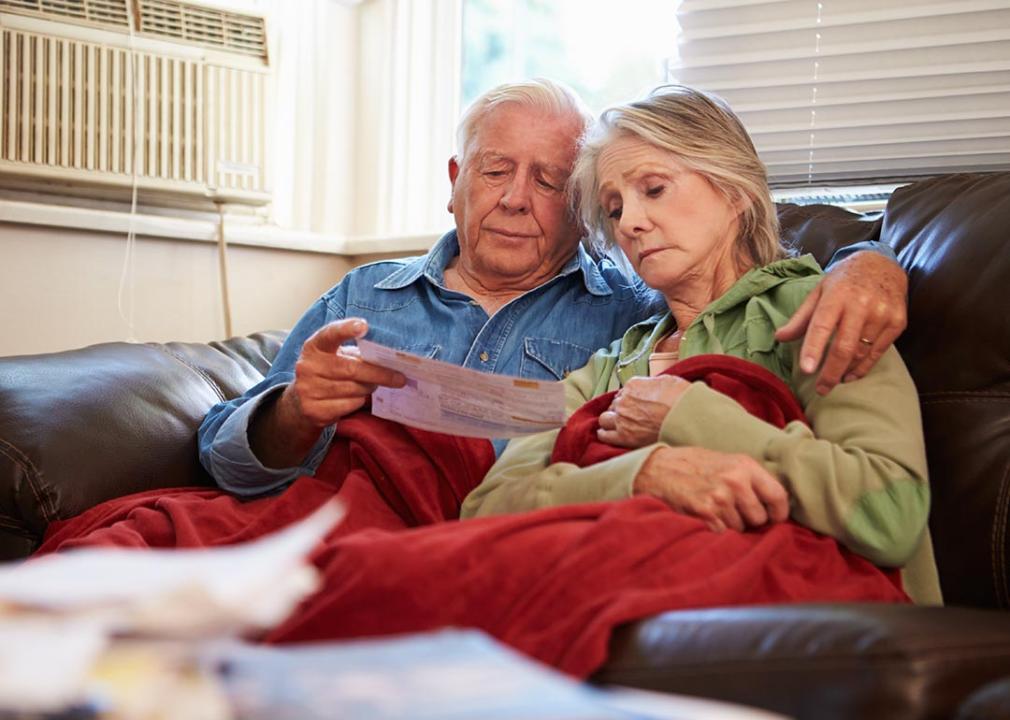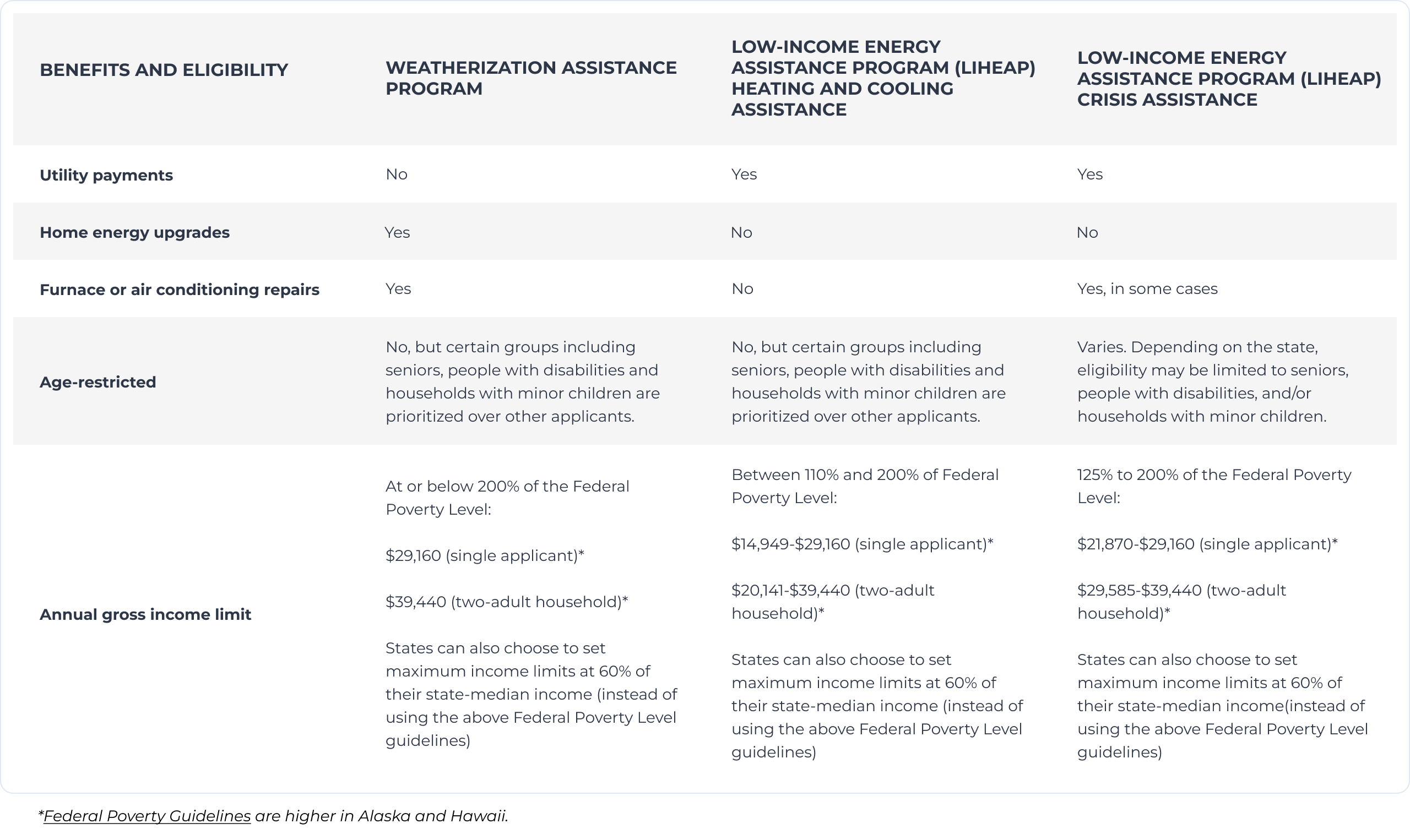
Keeping up with rising home energy costs can be tough, especially when household bills, like electric and groceries, continue to increase. According to the U.S. Bureau of Labor Statistics, average energy prices were 29.9% greater in June 2024 compared to June 2020. Caring.com reveals that this, combined with other rising expenses, leaves many low- and moderate-income seniors as well as those on fixed incomes struggling to cover costs. Caring.com reveals that this, combined with other rising expenses, leaves many low- and moderate-income seniors as well as those on fixed incomes struggling to cover their household expenses.
Oftentimes, these seniors may opt to cut back on their home energy use to help make ends meet. While that approach may keep the bill collectors at bay, turning down the thermostat in the winter and up in the summer can be dangerous. Many seniors are more susceptible to heat-induced complications as well as more sensitive to colder temperatures, putting them at risk of a number of serious weather-related health issues.
This guide compares two federally funded programs: the Weatherization Assistance Program (WAP) and Low-Income Energy Assistance Program (LIHEAP). It explains the basics of each program, including eligibility and application details, to help seniors access energy assistance benefits and maintain their homes at comfortable and safe temperatures.
Low- and moderate-income seniors may be eligible for home weatherization services, energy-saving home improvements, subsidies on their utility bills and emergency funding to cover overdue energy invoices through one of two federally funded energy assistance programs.
These programs, the Weatherization Assistance Program (WAP) and the Low-Income Home Energy Assistance Program (LIHEAP) are available nationwide.

In this guide, we've included information on two government-funded energy assistance benefit programs: WAP and LIHEAP. The WAP program funds home weatherization to reduce energy costs. States may use LIHEAP funding for general heating and/or cooling assistance programs as well as the Emergency Home Energy Assistance for the Elderly Program (EHEAP), depending on the needs of their residents. States may also have different eligibility criteria.
Sponsored by the Department of Energy and supplemented with funds from the Department of Health and Human Services, the Weatherization Assistance Program helps low-income households reduce their energy expenses through a variety of energy-efficient home improvements.
The WAP is the only federally funded energy assistance program that doesn't include any direct financial benefits for participants.
WAP is administered at the state level, and many states contract out their WAP services to regional governments and other agencies.
WAP funds can finance a wide range of energy-saving home upgrades and services delivered through approved contractors. These services may include:
On average, WAP beneficiaries save $372 each year on their home heating and cooling costs.
WAP benefits are available to low-income households. Although there are no age restrictions, seniors, people with disabilities and households with one or more minor children are prioritized. Priority is also typically given to households that have a high energy use and/or whose energy costs require a significant portion of their gross income.
WAP services can be used for all kinds of homes, including rentals and owner-occupied units. These include mobile homes, detached single-family homes, apartments, and townhomes.
The annual income limits for a household to be eligible for WAP services vary. Some states may choose to follow federal guidelines given by the U.S. Department of Energy and set maximum income limits at 200% of the Federal Poverty Level. Other states may choose to set the maximum income limit at 60% of the state-median income.
For states that follow the federal U.S. Department of Energy guidelines, 2023 annual household income limits for one to four-person households are given below. Benefits.gov lists income limits for larger households.
Federal annual household income limits for 2023:
Note: These numbers apply to all states except for Alaska and Hawaii. These two states have higher Federal Poverty Levels.
States that choose to follow LIHEAP program eligibility criteria and set income limits at 60% of the state-median income will have limits that vary by state. To determine what limits would be for your state, reference this chart from the Administration for Children and Families website.
If you or a member of your household receives Supplemental Security Income, Supplemental Nutrition Assistance or Aid to Families with Dependent Children, you may be prequalified for enrollment in WAP.
Reach out to your state's WAP program administrator to determine which income eligibility criteria are used by your state.
Applications for WAP are processed either directly through your state or a government-approved WAP partner such as a county government, tribal council or energy contractor.
If you live in a low-income household and you're struggling to keep up with your home heating and cooling expenses, you may be eligible for financial assistance through the Low-Income Home Energy Assistance Program. LIHEAP beneficiaries can apply for funds paid to their utility providers to reduce their energy expenses.
Emergency funding is also available for those who need help with critical furnace repairs during the winter or to purchase an air conditioner during extreme heat events. In some states, LIHEAP funds may also be used toward residential weatherization services for low-income households.
Similarly to the WAP program, states have some flexibility when determining income limits for LIHEAP heating and/or cooling programs. One option states have is to set limits according to the Department of Energy recommendations, or between 110% and 150% of federal poverty guidelines. To be eligible for LIHEAP benefits using these guidelines, your gross annual income cannot be more than $21,870 if you live by yourself. If you share your home with one other adult, your combined gross annual income can't exceed $29,580.
Another option available to states is to have a maximum income at 60% of the state's median income. This amount varies by state as shown in this table published on the Administration for Children and Families website.
States can also choose to pre-qualify individuals for LIHEAP based on whether or not they are already a beneficiary of certain government aid programs, such as Temporary Assistance for Needy Families (TANF), Supplemental Security Income (SSI) or Supplemental Nutrition Assistance Program (SNAP). Doing this may increase income limits for LIHEAP in these states. For example, to qualify for TANF in Illinois if you are over 60 or disabled, you must have an income within 200% of federal poverty guidelines. Receiving TANF benefits qualifies you for LIHEAP; therefore, you can have an income up to 200% of federal poverty guidelines, which is $29,160 annually for a family of one and $39,440 annually for a family of two, and still qualify for LIHEAP.
To determine what income eligibility guidelines are used by your state, reference this table on the LIHEAP Clearinghouse website. Keep in mind that states may change their criteria and you should double-check that the information provided remains current.
LIHEAP crisis programs offer assistance to vulnerable households experiencing an emergency crisis. These programs can make payments directly to the utility provider on behalf of families who have received a disconnection notice from their utility company, already lost their utility service due to nonpayment or can't purchase heating fuels as a result of financial hardship. Other types of energy crises addressed by these programs include dangerous conditions resulting from a state or national disaster that has damaged equipment or disrupted heating and/or cooling services. During these and other emergencies, states may use LIHEAP crisis assistance funds to cover repairs or replacement of equipment and/or supplies such as thermal blankets, portable air conditioners, or space heaters.
Eligibility policies for LIHEAP crisis assistance vary by state. Individuals may need to have a combined gross household income that is within 125% or 200% of federal poverty guidelines or at or below 60% of their state's median income level to qualify. Eligibility may also be limited to certain categories of vulnerable individuals. For example, the Emergency Home Energy Assistance for the Elderly Program in Florida requires households to have a member over the age of 60 to receive benefits.
Find out situations that qualify for LIHEAP crisis assistance in your state as well as your state's income eligibility criteria by referencing the LIHEAP Crisis page on the LIHEAP Clearinghouse website. If funding is available, crisis program beneficiaries may be able to receive assistance more than once during the same year, though this also varies by state.
Each state administers its own LIHEAP, and in most areas, there are specific filing dates for assistance with heating, cooling, and energy crises. Note that LIHEAP funds are limited and may vary from year to year, so if you need help, it's important to apply well in advance of your state's filing deadlines. Fortunately, many states offer early application opportunities for vulnerable populations so that they are more likely to get the assistance they need.
Some programs may also be limited only to specific high-need households due to a large demand for assistance and limited resources. When this is the case, it is noted in LIHEAP State Filing Dates. You can also use this table to find your nearest LIHEAP administrator. Simply click on the name of your state and you will be taken to the administrator's website.
If you're interested in reducing your home energy costs and you don't qualify for any of these federally funded energy assistance benefits, you may want to contact your utility company or your local Habitat for Humanity chapter.
Many utility providers offer a range of services to help customers control their home energy consumption rates, such as:
Some states, including New Jersey, Oregon and Wisconsin, collect a surcharge from ratepayers who use energy services provided by for-profit utility companies. The funds collected are applied toward programs to help low-income ratepayers, invest in renewable energy projects and subsidize energy efficiency initiatives for homeowners.
Habitat for Humanity is an international nonprofit organization dedicated to improving access to safe, affordable and accessible housing. Most of Habitat for Humanity's work is performed by volunteers.
In the United States, a number of Habitat for Humanity chapters offer the Aging in Place program, an initiative designed to help at-risk seniors retain their independence and community connections. Through this program, eligible seniors can access a host of home repairs, modifications and improvements to make their homes safer, easier to maintain and more affordable to own.
Eligible seniors may be able to use the Aging in Place program to get help with energy-efficient upgrades such as installing new windows and doors, enhancing insulation in their walls and attics, and replacing inefficient heating and cooling systems.
You may qualify for help through the Aging in Place program even if you already receive benefits from one or more government-sponsored energy assistance benefits such as the WAP or LIHEAP.
Programs like LIHEAP and WAP offer energy-efficient home modifications or assistance paying energy bills to seniors with qualifying incomes. Regional utility providers and Habitat for Humanity groups may also be able to assist. While these energy assistance programs are for seniors living independently, seniors who need or want someone else to look after their utility bills should consider assisted living as an option.
This story was produced by Caring.com and reviewed and distributed by Stacker Media.